Milk kefir is very easy to make at home and far cheaper than buying ready made. If you want to benefit from all the healthy probiotics in this fermented milk drink, it’s simple and cheaper to make it yourself. Simply ferment, strain and serve. Here’s how!
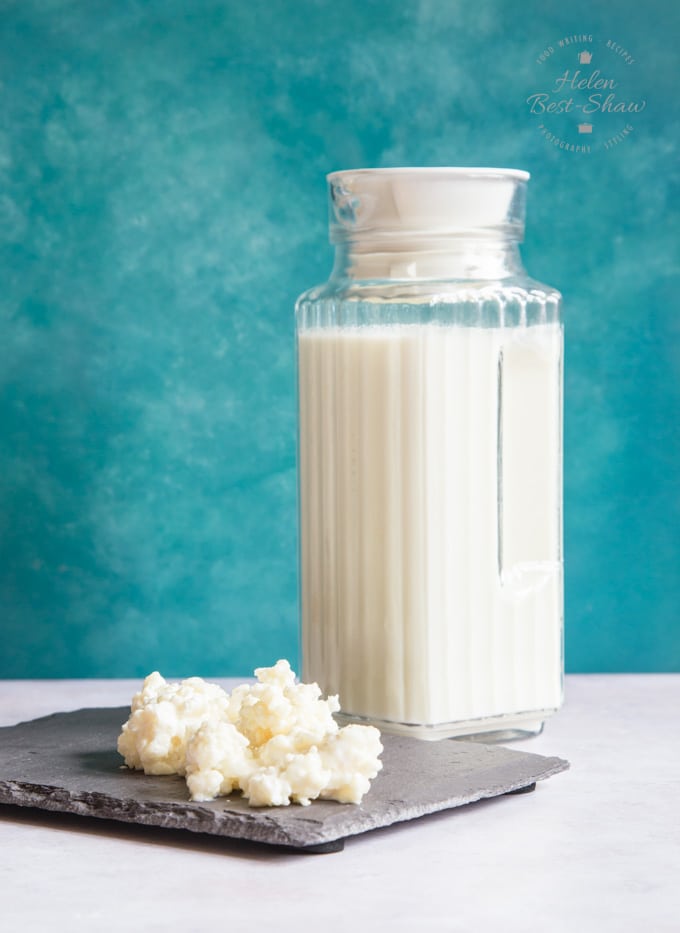
What is kefir?
Kefir is a type of fermented milk, similar to yoghurt, with many health benefits. I’m a big fan; I’ve been making a batch once a week for at least the last ten years, so I’ve made well over 500 batches over this time.
I’m talking about milk kefir here. Water kefir is a different ferment, made with different type of kefir grain and a water / sugar mixture.
See Also
- Everything you need to know about kefir – get geeky about kefir with this guide
- How about making our Easy Kefir Yeasted Bread Recipe?
- Or make our Berry Beetroot Smoothie with kefir
How can I make kefir?
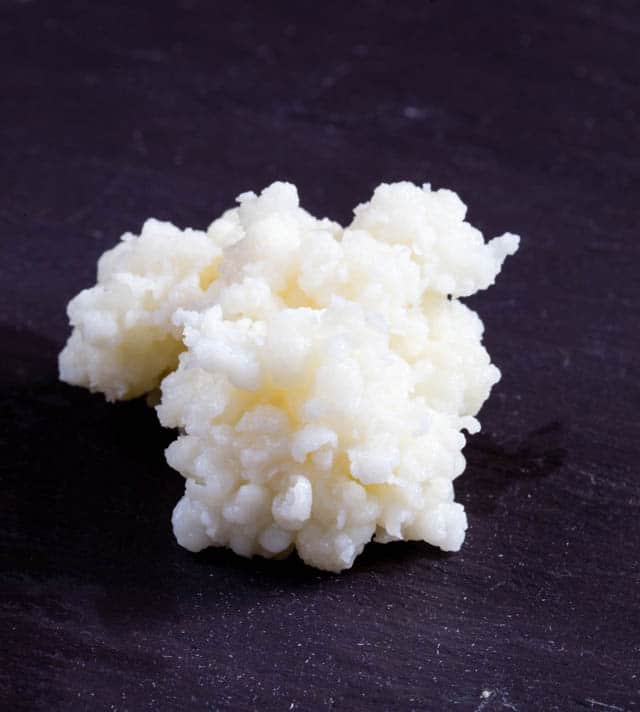
Milk kefir is made by adding kefir grains to milk, and allowing fermentation to happen.
Kefir grains range from the size of grains of sand to rice; they combine into blobs about a few centimetres across that resemble cauliflower florets. They are white to cream coloured.
You can also make kefir from a powdered kefir starter. Unlike grains, the powder has a limited lifespan; it will make up to about seven batches, but it will then need replacing with fresh powder.
If you use kefir grains instead of powdered starter, you can keep making kefir indefinitely.
Helen’s Fuss Free Tip
Despite being called “grains”, milk kefir grains are something completely unrelated to cereal, wheat or oat grains!
How to Make Milk Kefir
It’s simple!
In a nutshell …
1 – add kefir grains to milk and cover
2 – leave to ferment on the worktop until thickened
3 – strain, cover the grains with milk and put into the fridge for next time
However making kefir can be daunting for beginners so follow my tutorial below with photos for every step so you can be confident of making kefir, know exactly what is normal and how to get the best from your grains.
After 3 batches you will wonder what all the fuss was about and be well on your way to becoming a kefir pro like we are!
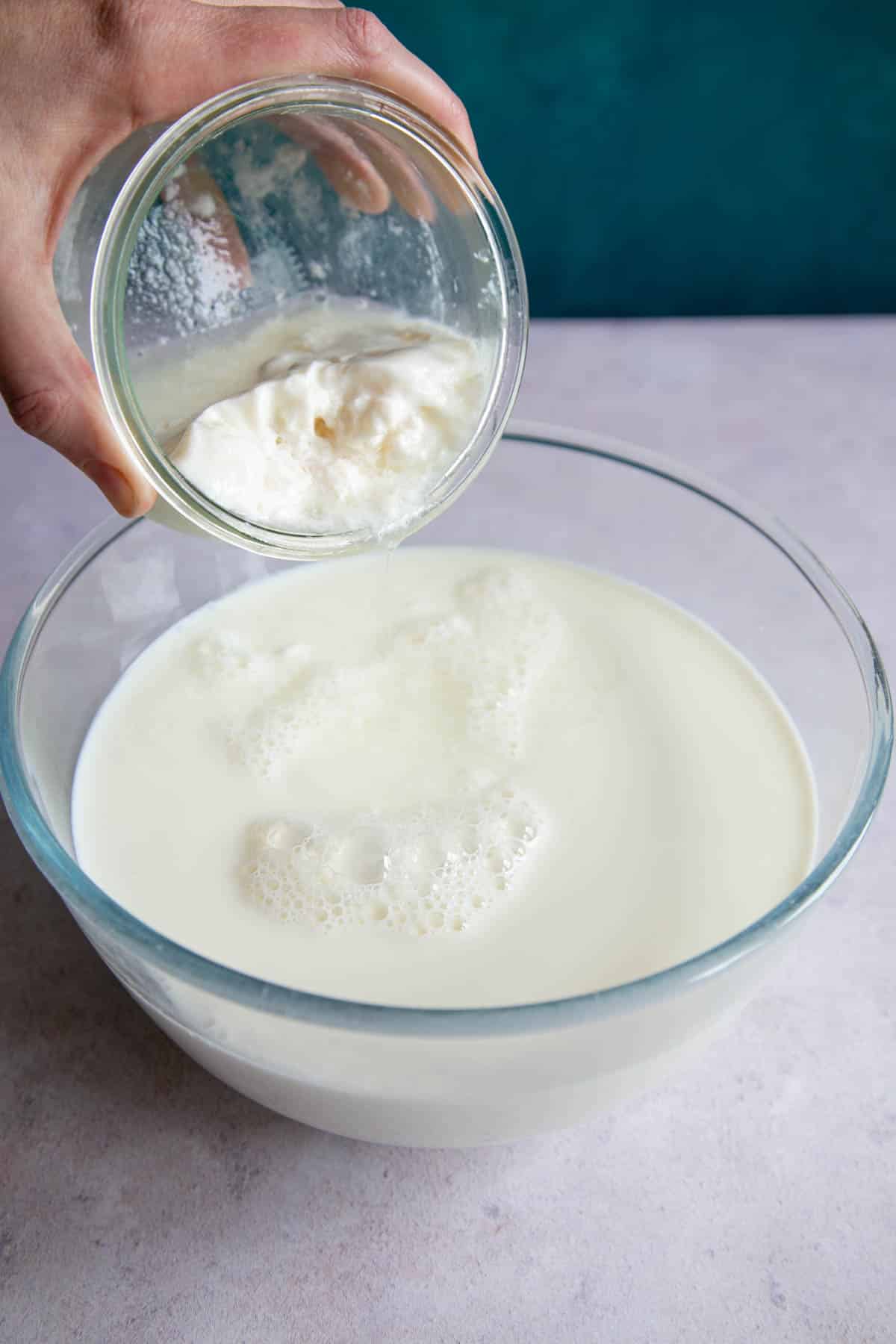
Step one – Add the grains to the milk, cover, and leave on the countertop, out of direct sunlight, for up to 24 hours. We use a glass bowl with a lid, but you can use a jar or bowl.
Use a glass, plastic or ceramic bowl, not stainless steel. There’s no problem in using a stainless sieve to separate the kefir from the grains, but it’s best not to leave the kefir in metal for extended periods.
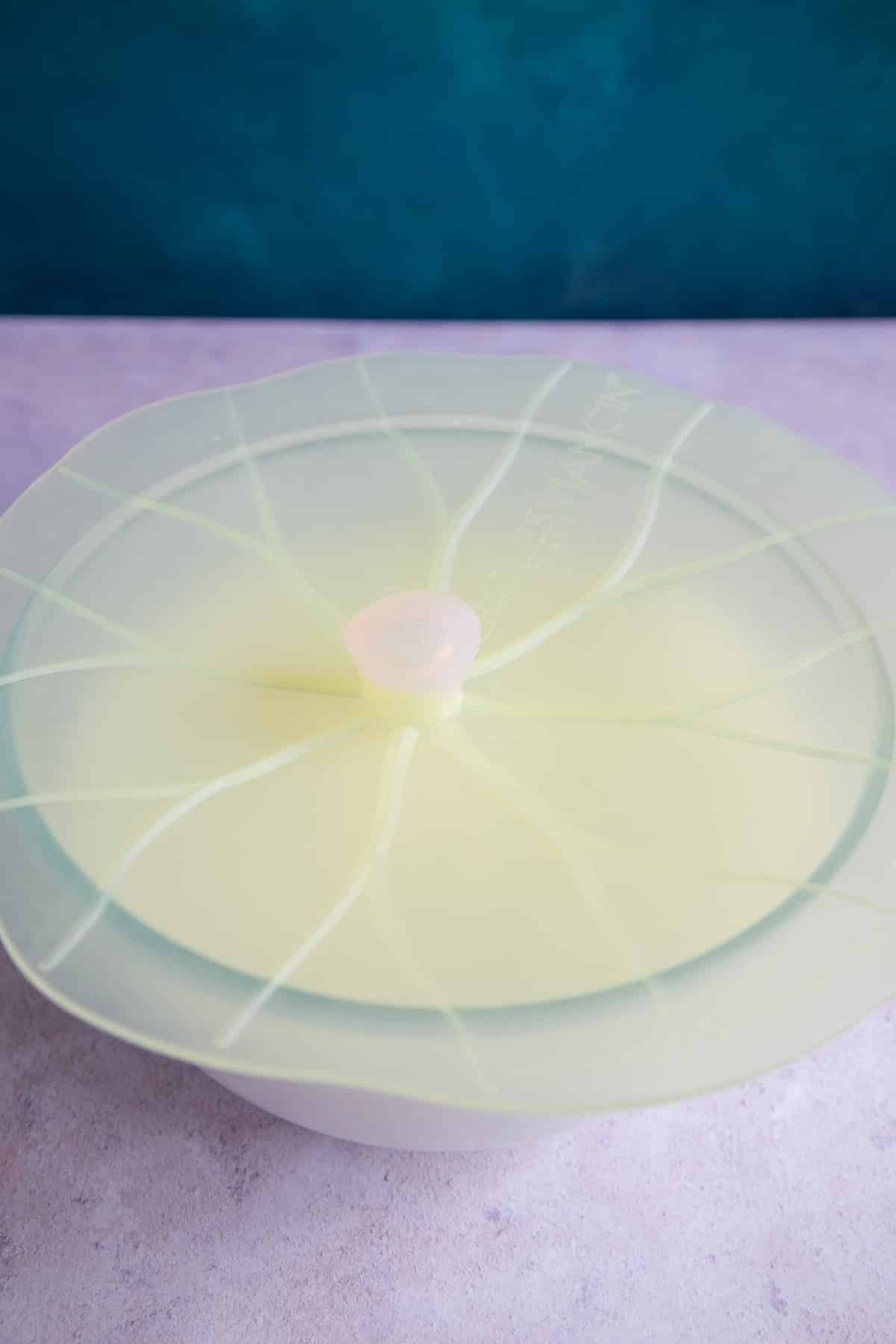
Make sure the lid is not airtight so the kefir can breathe, and that pressure won’t build up in the container.
If possible, give the mixture a good stir every few hours to get fresh milk into contact with the grains. The warmer the temperature, the faster the milk will ferment, and also you’ll learn how sour and thick you like your kefir.
Don’t fill your bowl or jug right to the brim. Carbon dioxide is produced during the fermentation process, so the liquid will expand a little. Give it some room for this! For the same reason, don’t seal the container with an air-tight lid. I use a reusable silicone cover that’s perfect for the job.
Give your kefir a stir twice a day.
The milk will thicken; you can decide when it’s reached the state you like. I find that it’s usable after about 12 hours at room temperature – less on a hot summer’s day – but I tend to leave it longer.
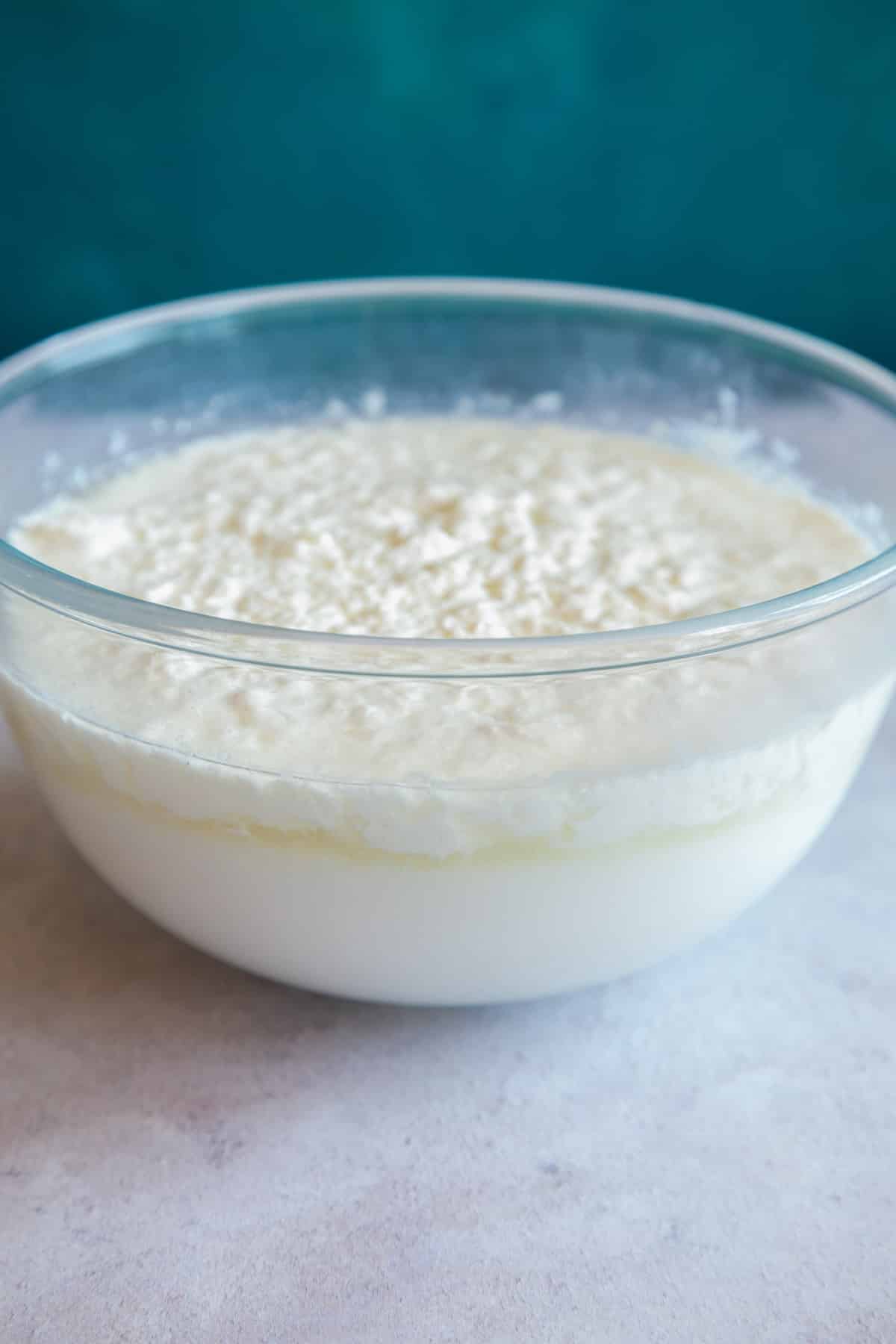
After 24 hours or so (in a cold room, it might take as long as 48 hours in the winter, or even 3 days in the fridge), you’ll see that in the top quarter of the bowl, the milk has separated into a pale and a thick, white liquid.
If you stir it at this point you will find it is significantly thicker.
Step two – separate kefir from grains. Once the milk is sufficiently fermented, you need to separate the grains from the kefir: simply sieve out the grains, and they’re ready to start on the next batch.

As the kefir has thickened, you need to use a spatula to push the liquid through the sieve. You’ll also find that the kefir remains on the bottom outside of the sieve, and will need to be scraped off.
Pro Tip – metal sieves
Some people prefer not to use metal sieves to separate the grains from the kefir, but I’ve never had any problem. The grains are in contact with the sieve for a very limited time. However, I would only use a glass jug for storage, and a plastic, glass or ceramic container to make the kefir.

Step three – transfer kefir to a clean glass bottle or similar container remembering to leave some space at the top!
I keep my kefir in the fridge for up to a week. It can undergo a slow secondary fermentation, but I quite like it when it’s quite sour.
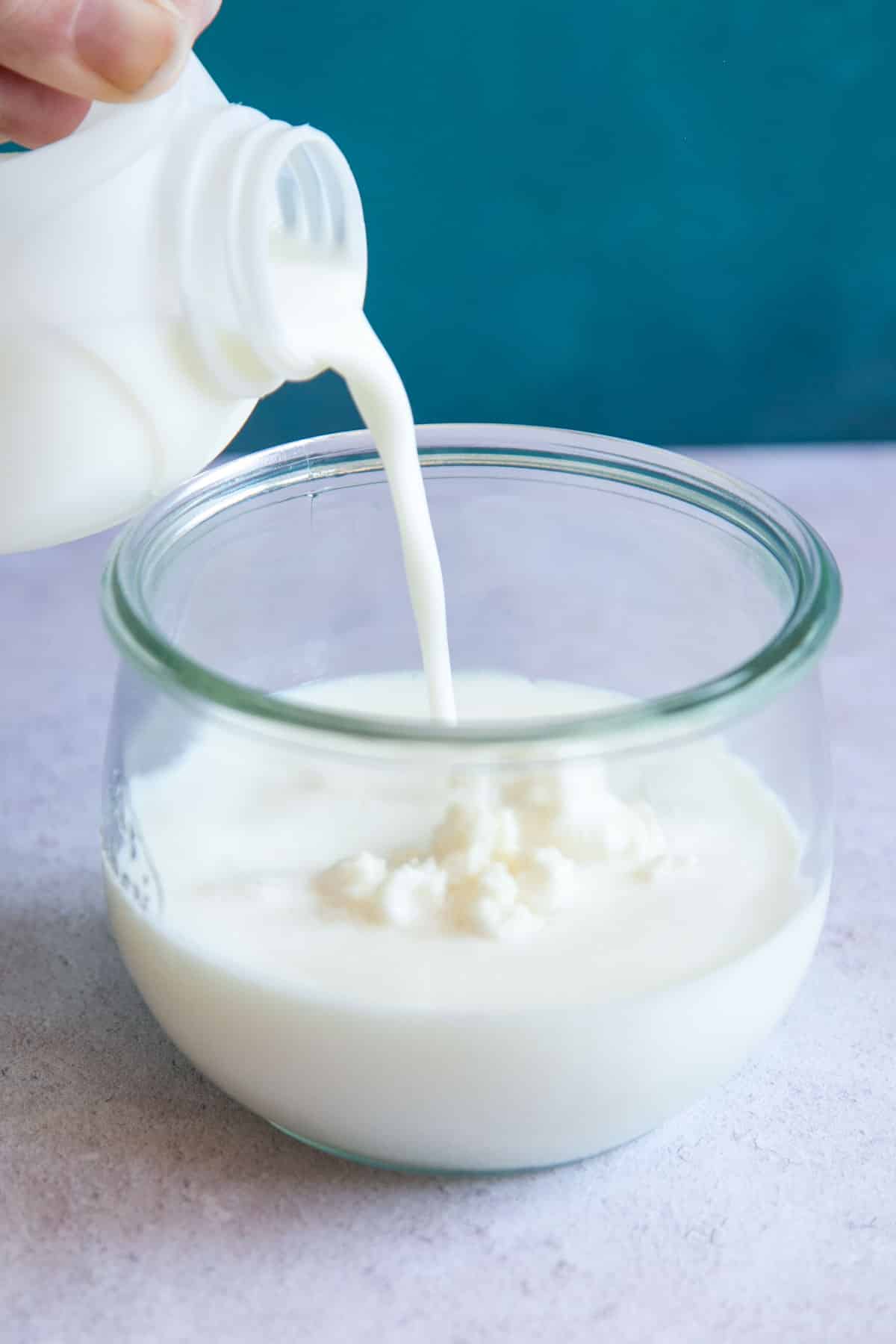
Either start your next batch straight away, or if you are not ready for another batch, then pop the grains into a jar, cover them with milk (it does not matter which type), cover with a loosely fitting lid on top and keep in the fridge for up to two weeks.
Once you are ready to make a new batch you can simply add the grains and kefir mixture straight from the fridge into your bowl, ready for the milk.
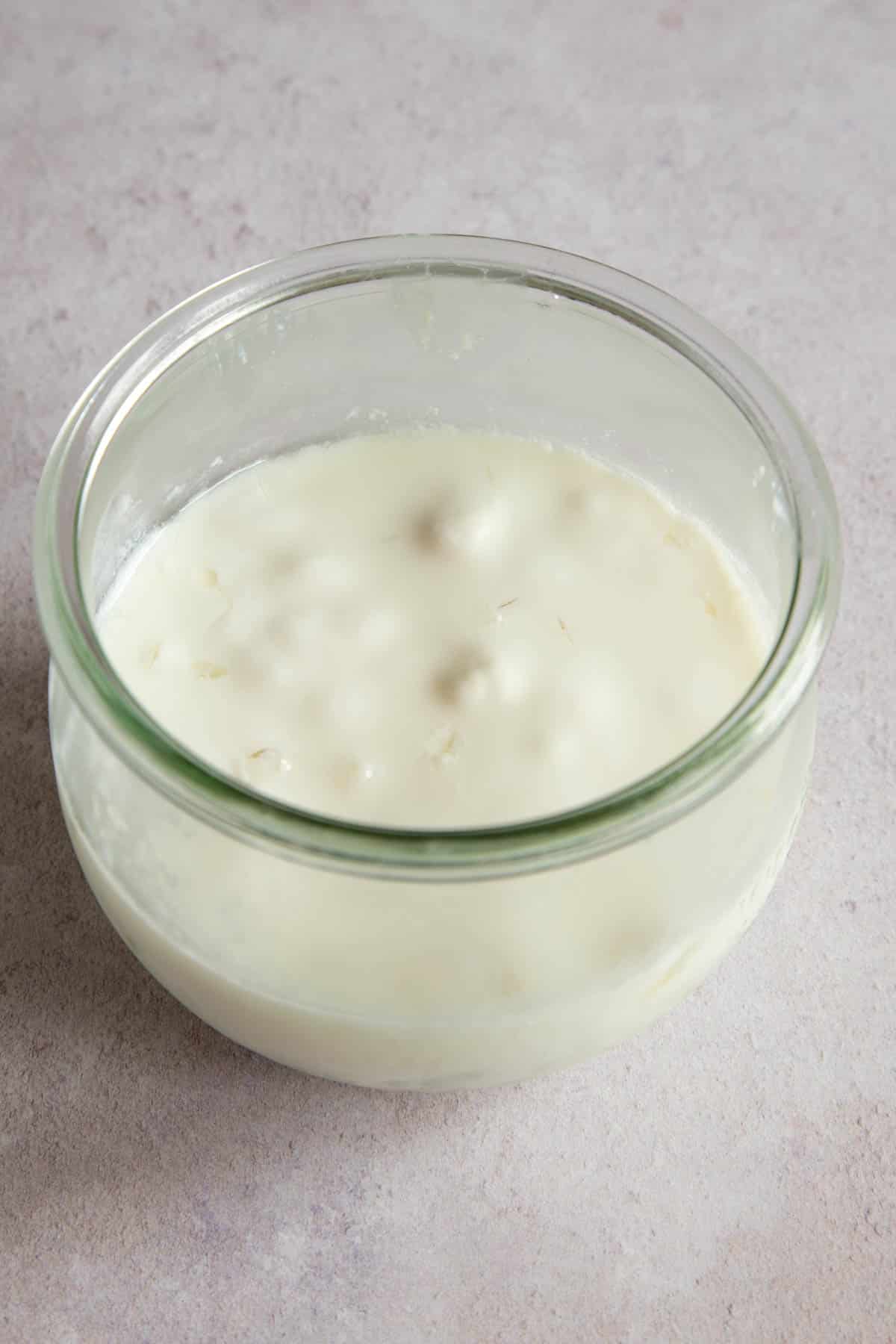
If you leave the grains for more than a few days they will be coated with a thick mucus, and the kefir surrounding them will be set and solid. This is normal and nothing to worry about.
If you have not made fresh kefir for a few weeks the grains may be quite sluggish for the first few batches and take longer to ferment the milk. They will recover and soon get back up to speed.
My kefir has separated! What can I do?
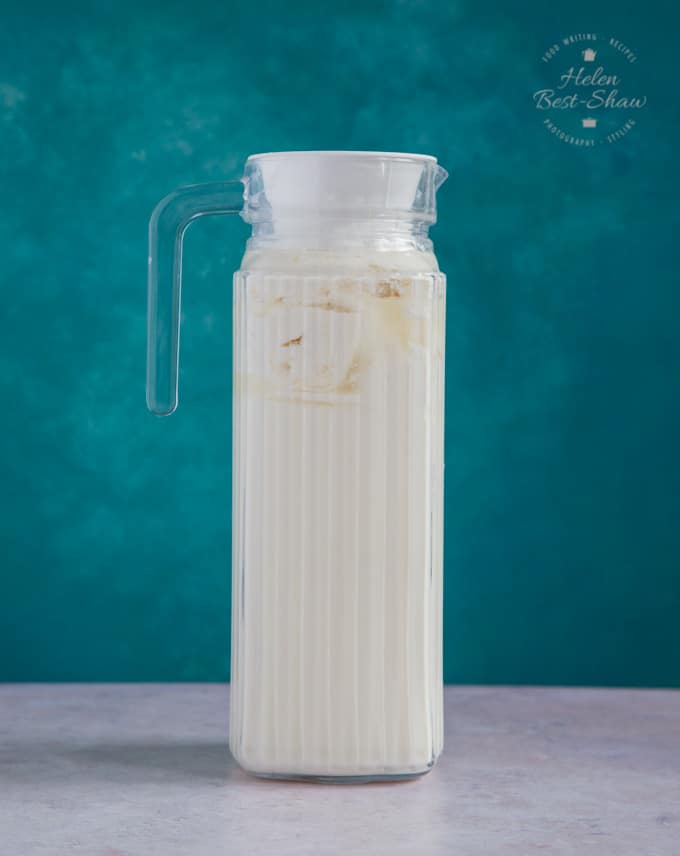
Don’t worry, it’s not a problem! You can just stir or blend it all back together, or should you want you can strain off the whey (I use it in bread making), and make kefir labneh.
How much kefir grain should I use?
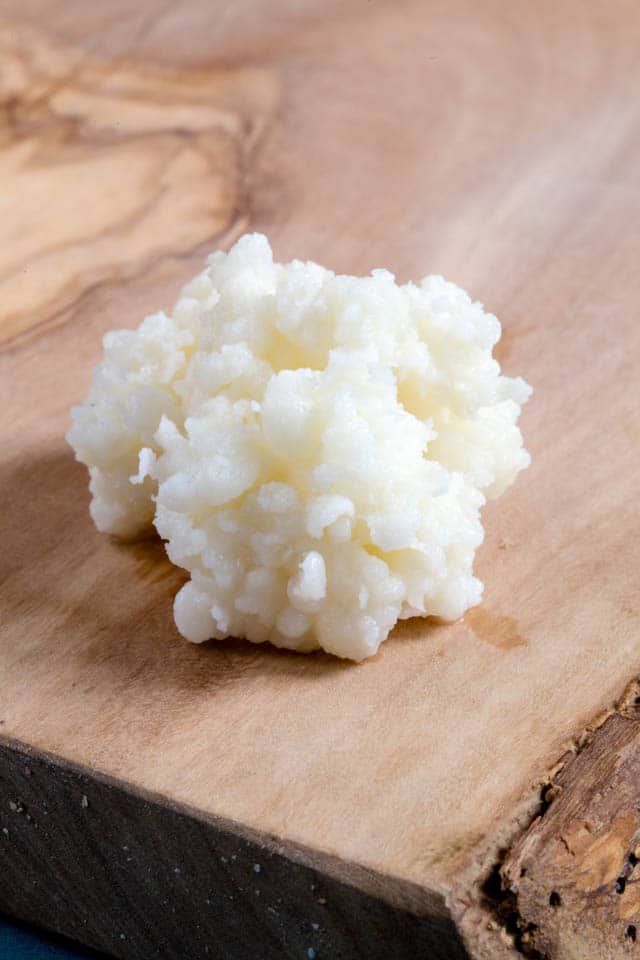
We use grains weighing 5-10% of the weight of milk. In this range the amount used seems to make no difference to how finished kefir looks or tastes, but more grains do ferment faster.
That equates to between 3 and 6 tablespoons, or a scant 1/4 to 1/3 a cup of grains for 1 litre of milk.
You don’t have to be at all precise with these measurements. More grains will just ferment faster.
What is “secondary fermentation”?
The grain-free kefir is still a live product, and homemade kefir will continue to change, ferment and thicken in the fridge. Despite the straining there will almost certainly be some tiny grains which pass through the sieve which speed up this process.
We find the kefir gets noticeably thicker and more sour the longer we leave it.
If you want to stop, or at least slow down, the continuing fermentation try straining your kefir twice before putting it the fridge. We have found this makes a big difference.
You can also add a flavouring to the fresh kefir, and let the added sugars ferment and develop the new flavour.

I don’t want my kefir to be so sour.
As the kefir matures, it becomes more sour. If you would like a sweeter tasting kefir, separate it from the grains earlier, as soon as all the liquid is showing signs of having thickened.
Also, drink or use the kefir immediately. Any secondary fermentation will give a more sour result.
What sort of milk should I use for making kefir?
We get the best results from using pasteurized full fat milk, but you can also use semi-skimmed or skimmed. Skimmed and semi skimmed milk will make a much thinner kefir.
You can make kefir with cows’, goats’ or sheep’s milk. The higher protein levels of sheep’s milk will give a thicker and creamier kefir, while goats’ milk kefir will be thinner. Both will have a different taste to cows’ milk kefir.
No Fresh Milk? Use Powdered or UHT Instead
If you don’t have fresh milk you can use powdered milk or UHT to make your milk kefir. We tested both ways recently and they do ferment.
BUT because most milk powder is skimmed milk powder we recommend using more powder to make your milk up than the instructions recommend. As soon as you can, refresh your kefir in regular full fat fresh milk.
UHT – ultra high temperature pasteurised milk, which has a long shelf life and doesn’t need refrigerating before opening can also be used to make kefir.
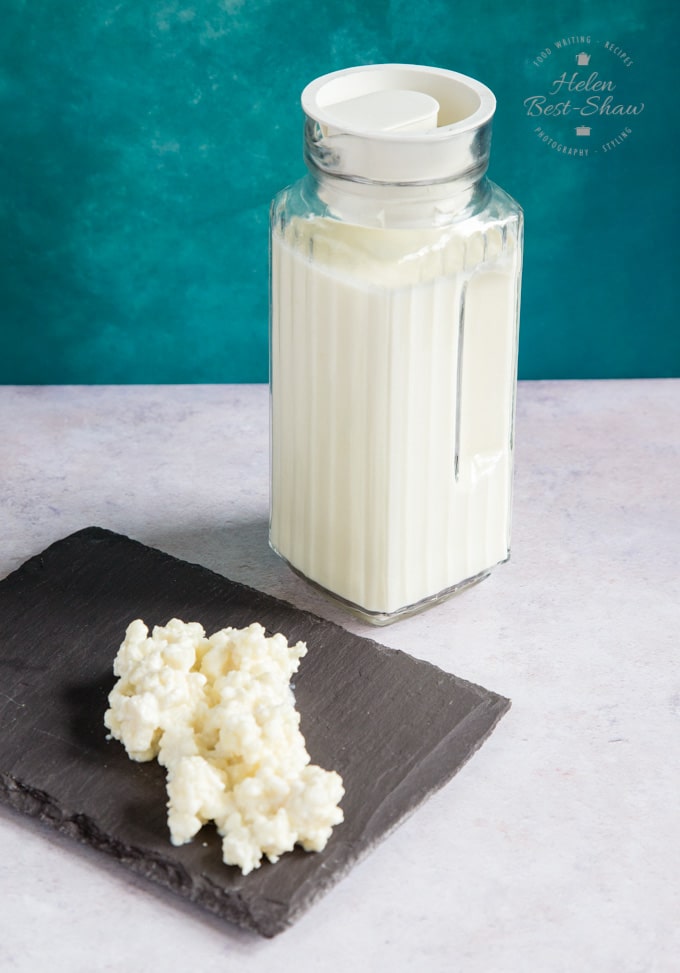
How to make milk kefir
Ingredients
- 50 g (0.25 cups) kefir grains (you can use up to 100g)
- 1 lt (4 cups) milk (we get best results from full fat milk)
Instructions
- Add kefir grains to the milk, in a large bowl. Cover loosely and leave on a kitchen countertop.
- After about 24 hours (or longer, if weather is cool. say under 20C), when the kefir has thickened, it's ready. Sieve out grains from fermented kefir. Push the kefir through the sieve with a spatula. Scrape kefir from the outside of the sieve – don't let any go to waste!
- Transfer the kefir to a jug for storage in the fridge, or use immediately. Leave about 2.5cm/1" at the top of the jug for the kefir to expand.
- Drink or use kefir right away, or it will keep in the fridge for up to a week. Or add flavourings for a secondary fermentation.
- Add grains to fresh milk to start the next batch of kefir, or store just covered in milk in the fridge.
Notes
- Makes one litre, but it’s easy to make more or less: just adjust the amount of milk you use, and then use kefir grains that weigh a total of 5 and 10% of the weight of milk.
- Once made, kefir will get thicker and more sour as it keeps in the fridge.
- Separation is natural: just stir before using.
- Timings for the fermentation will vary according to room temperature and how much kefir grain you use. It will take about 24 hours at temp of around 20°C/70°F.
- Nutrition information is per 100ml of kefir made with full-fat dairy milk.
- If you’re not making kefir for a while, store the grains in the fridge covered in milk. The milk will become thick and jelly-like. To make a fresh batch of kefir, rinse the grains under running water and add to fresh milk as normal. This batch may take a little longer than before, but after a few batches, the grains will be behaving as normal.
- Kefir and kefir grains have as slightly sour but fresh smell. If either smells funky, discard grains and kefir, and start from scratch with new grains.
- If you want to make it paleo, you can use coconut milk. But keep the kefir healthy by making milk kefir once per three times you use coconut milk.

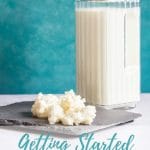
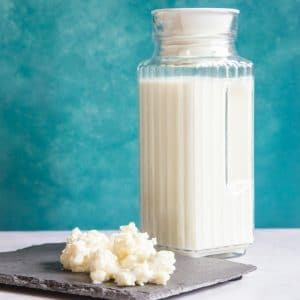

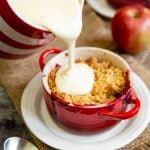


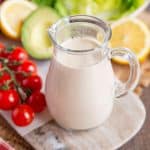






kim
I’ve never tried Kefir milk, but thanks to all of your great info, I definitely will soon! Love how easy you made it sound to make!
Helen
So easy to get started and keep it going.
Dawn - Girl Heart Food
Hubby really enjoys kefir! What a neat idea to make at home! Love all your instructional pics too :)
Helen
So easy to make, and a lot cheaper too.
Tara
I have heard of kefir, but actually haven’t tried it myself yet. I love how much information you included in this post. Definitely need to give it a try!
Helen
We’re a great fan of making our own kefir, so much fun too.
Susan Moran/theviewfromgreatisland
This is absolutely fascinating, Helen, I knew nothing about kefir and now i feel like I’m ready to take it on! I love yogurt and we make it homemade all the time, so I’m super excited to get started with kefir ~ want to send me some grains??
Helen
I fear the grains might not make the trans Atlantic trip safely!
Lisa | Garlic & Zest
I’ve never tried kefir before, but I did get some for my daughter after she had a jaw surgery and could only have liquids for a week… She liked it, so maybe I should give this a go. Great tutorial and explanations.
Helen
It is great to introduce gradually in to your diet, lots of benefits.
susie
What an amazing article. You really gave useful in-depth knowledge of kefir. We love drinking it at our house for the benefits you listed, but have yet to make it on our own. This might have to be my summer project.
Helen
Great to make your own, and so easy to do.
Grace L
I have only ever heard of Kefir, but knew nothing about it at all. This is a really interesting read and I’m really keen to give it a go.
Helen
It’s so easy to make, with lots of benefits.
Robert Joy
My sister drinks this regularly, but as far as I am aware she buys ready made. I should tell her about this, it seems to be very successful.
Helen
Very easy to make and very successful.
Zara Douglas
This is really intriguing. I often avoid using dairy milk due to eczema, but this may be a suitable alternative.
Helen
Kefir can be a good alternative for mild dairy intolerances.
Penny
I love that your dog benefits from the kefir too. Kefir sounds like a great way to add the good bacteria in to your diet.
Helen
Herbert very much approves of our kefir making.
Hollie Jackson
This is fascinating. I love a bit of science with food. I’d really like to try making some kefir. Will have to get hold of some grains to start off.
Helen
I do find it interesting too. Do have a look at the Facebook groups, very helpful.
Ren
Such a useful and fascinating post. My Polish grandmother used to make and drink kefir everyday so it was commonplace in our kitchen. It’s funny to see how it has grown in popularity again. I’d love to try making my own and it’s a great idea to add it to smoothies.
Helen
It is so easy to make, and such a good source of good bacteria.
Fee
Very interesting to read this. I started used goats milk for my overnight oats, as I found it kinder on the stomach. I may give this a try, all sounds good to me.
Helen
Great for overnight oats, we add some grated apple to ours. Delicious.
Donna G
I started drinking kefir a couple of years ago, and found it a rather acquired taste, but you soon get used to it. Better to think yogurt than milk, it certainly isn’t creamy. But great for you. I haven’t made my own and am surprised how easy it all sounds.
Helen
Really easy to start off and keep it going.
Michael B
I actually didn’t realise it was that easy to make your own Kefir. Great thinking, Helen.
Helen
So easy to make.
Kelsey Wright
This sounds like something good for having a healthy gut. I find the little bottles you get, like yogurt are so expensive.
Helen
You would save a lot by making your own Kefir.
Yasmine Kirkwood
I got in to making Kefir after my friend showed me how easy it was. She started me off. It really is a share thing, pass the grains on. It’s brilliant.
Helen
It really is brilliant and that easy.
Billy
Thank you so much for this helpful guide! can’t wait to make my own milk kefir at home. Definitely excited to not have to buy it from the store anymore!
Helen
So easy to do, and a great way of saving too.
Sara Heyes
Really interesting, Helen. Very good that the process can work for lactose intolerant people. Suffer with my stomach, always have, doctors hopeless, so will give this a try, Huge hug to Herbert
Sara x
sugarpawz
If you like yogurt and drinking yogurt, try kefir. I suggest that you start slowly, with a small glass or so, to see how you get on (too much too soon can cause a tummy upset – give yourself time to adjust), before drinking larger quantities.
Jitka
I come from central Europe and love kefir. I had serious craving for it during my first pregnancy ?. I live in the UK now and was quite disheartened by the price of kefir in supermarkets (although much cheaper in Polish food shops). I am therefore excited to find out how easily it can be made at home. Plus my friend gave me some kefir grains too. I am looking for ideas on how to add flavour to my kefir. I would usually buy vanilla or fruit flavoured kefir in shop. How to achieve this at home? Crushed fruit, jam, cordial, vanilla extract?
Helen
Hi Jitka,
Kefir has become crazy popular over the last few years, and it is shockingly expensive. We’ve been making our own for about 4 years now and rarely buy it in the shops. Home fermented is always nicer – as well as cheaper it is thicker and you can adjust how sour it is by leaving it fermenting for longer.
I never flavour mine – but I think whizzing into a smoothie with soft fruit would be good, or adding a little vanilla extract.
Jade
Very informative information on here. I haven’t ever tried Kefir so I have a couple of questions. Could you use it as an entire alternative to milk? So have it with cereal in the mornings and things? Would you leave it in a liquid form for this and keep it for you to 3 days? How long would you let this ferment for? I was then wondering to use it in the coronation chicken recipe, how long do you let it ferment for and how long can you keep it? Would it then be 3tbs of Kefir instead of mayonnaise and Greek yoghurt?
Thank you.
Helen Best-Shaw
You can absolutely use it as an entire alternative to milk, although I would start slowly to get used to it. We use it on our overnight oats in the summer.
Fermentation time varies wildly according to the season. In the height of the UK summer a batch can be done in half a day, and in the winter in our unheated kitchen it can take several days. It also depends on how many grains you have and the last time you refreshed them.
We make one batch a week, which over the 7 days, kept in the fridge progressively gets thicker and sourer in flavour. This wont happen with commercial kefir as it is microfiltered to remove any tiny grains.
You could certainly add some kefir to the Coronation chicken recipe, but it will also need a dollop of something thicker as kefir by its self isn’t thick enough to make a coating sauce.
Cally Roberts
Hello. Is whole wheat grains best to use as your grain? Will wheat germ and/or wheat bran work? Or oat bran?
Helen Best-Shaw
These are kefir grains – nothing to do with cereal grains